With the increase in demand for contact center agents and the shift towards WFH agents, contact centers need to find ways to scale up operations, improve their process efficiency, source candidates more efficiently, and retain them for longer.
Contact center leaders need to look at where and how to adopt technology to enable their digital transformation. In particular, they need to know what processes to automate and how to do so in order to hire faster and better.
And the solution is not to invest in recruitment tools or automate tasks randomly; a partial digital transformation that’s not well-thought-out won’t be sufficient. Contact center recruitment digital transformation is an investment that ultimately saves you time and money if executed with the bigger picture in mind.
In the last year alone, we’ve handled the digital transformation of global organizations in the BPO space, such as Arvato, who have teamed up with Harver to tackle challenges such as employee attrition, hiring bias, or recruitment efficiency.
So, if 2021 is the year you plan to start digitally transforming your BPO or contact center recruitment process, this article will give you the framework you need.
What’s in?
Like what you see?
Don’t miss out. Subscribe to our quarterly digest to get the latest TA and TM resources delivered right to your inbox.
Why the digital transformation of contact centers should start with recruitment
In 2021, contact centers are facing some of the biggest challenges they’ve ever come up against. Volume hiring, while always complex, has reached new heights of difficulty due to changes in both consumer behavior and the labor market.
Employee attrition
Employee attrition is the number one challenge that contact centers are facing, globally. In the US, average employee attrition rates are 15%, but in contact centers, these numbers rise to between 30-45%.
The issue with this high number is twofold – one, it’s costly, and two, the majority of contact centers simply accept that employee attrition is the nature of the beast, rather than viewing it as a problem to be solved.
While there is the “normal” attrition – caused by retirement and internal attrition, where employees leave one department for another, these don’t make up the bulk of attrition. It’s the other types of attrition that are the costly ones:
- Involuntary attrition
- Voluntary attrition
- Demographic attrition
Attrition is directly related to recruitment, but how does digital transformation help in tackling this challenge?
As part of their digitization efforts, contact centers are adopting recruitment software that can recognize the skills linked to better on-the-job performance, thus helping recruiters make better hiring decisions, backed by data.
At the same time, leaders in the contact center vertical are incorporating custom pre-employment assessments in their application process. These assessments offer candidates realistic previews of the job, enabling them to filter themselves out during the application process if their expectations aren’t met.
Hire better live chat agents, at scale.
Dive into the rise of live chat, the skills of top-performing agents, and how to best assess them to reduce attrition and guarantee top-notch customer service.

Productivity is impacted by recruitment
Who you hire and how you hire – when it comes to recruiting call agents – affects the productivity of the whole contact center. When you recruit and hire people who don’t have the skills to become top performers in your contact center, you’ll experience higher than average involuntary and voluntary attrition.
The opposite is true as well: selecting the right candidates – with the right characteristics and skillsets – ensures a higher quality of hire and as a result, a more productive workforce. We’ve covered the qualities you should look for in a top-performing contact center agent, as well as how recruitment software can help you select candidates at scale, in the article below.
Candidates are your brand’s voice
Your customer-facing employees are your brand’s voice, and in contact centers, phone and chat agents handle most customer interactions. This means that when you write job descriptions and select applicants to fill such roles, you need to prioritize those skills that reflect your organization’s values.
For example, contact center agents who lack empathy and customer orientation skills might do more harm than good, especially if assigned to phone roles, as customers can pick up signals from the way they communicate.
Candidates who lack multitasking skills may not be the best choice for chat agent roles, where they need to solve multiple customer queries at once, and to do it not only accurately but also in a friendly manner.
While these differences are hard to spot by simply screening a resume or interviewing a candidate, technology can help you find the applicants who possess a set of predefined characteristics that are predictive of job performance.
For example, our call-type matching framework helps recruiters move away from selection procedures that are built around specific job descriptions, and adopt a new approach to volume hiring, which matches the best-suited applicants across multiple opportunities and roles.
You can learn more about this framework in our webinar on Contact Center volume hiring trends.
Costly and inefficient processes
Bad hiring processes negatively impact your bottom line, not only because employees are leaving after you’ve spent money on finding, hiring, and training them, but also because your recruiters are wasting hours doing manual tasks that can be perfectly handled by machines.
If your recruitment funnel relies on manual tasks such as screening resumes and scheduling interviews, you’re fighting a losing battle, especially when dealing with high volumes of applicants.
Manual processes can’t be scaled up unless you hire more recruiters. Then, when hiring at scale, it’s much easier to make biased decisions and select the wrong candidates; the costs are around $2,500 per wrong hire.
Now, if your call center is of average size and your attrition rate is average for the industry (30-45%), when you’re losing an average of $2,500 for each employee attrition, your recruitment mistakes are costing you $1m+ annually. That’s food for thought.
If you want to explore these challenges further, we take a really deep dive into them in our white paper below.
- White paper
Before you continue!
Don’t forget to grab your free copy of our white paper on contact center volume hiring in 2021. Learn about:
-
The challenges currently shaping the contact e
center recruitment space - How employers can navigate the new remote-first reality, and the role of technology in a future-proof recruitment process
- The four building blocks of a fully digital recruitment process

What is digital transformation in contact center recruiting?
Digital transformation in contact center recruiting means identifying the digital technology that will enable your contact center to deliver a world-class candidate experience, resulting in an outstanding customer experience and streamlined processes.
This can mean updating legacy technology or implementing new tools and ways of working to automate recruitment processes, thereby increasing your efficiency, reducing costs, and allowing you to make data-driven hiring decisions.
Having said that, undertaking a digital transformation is one thing, but it doesn’t guarantee automatic improvement in a company’s performance.
According to a report by McKinsey, transformations are hard, the digital ones are harder. However, there are some factors that improve the chances of a successful transformation, and they fall into five main categories:
- having digital-savvy leaders in place
- building capabilities for the workforce of the future
- empowering people to work in new ways
- upgrade the digital tools used by the workforce
- communicating frequently via digital methods
Which stages of the recruitment process should be digitized?
In a contact center yet to undertake a digital transformation, numerous processes tend to be manual. The traditional recruitment funnel goes through these phases:
- Advertising the role
- Reviewing applications and screening candidates
- Scheduling calls and interviewing candidates
- Selecting the best-matching candidates
- Sending the job offer
- Hiring the selected candidates
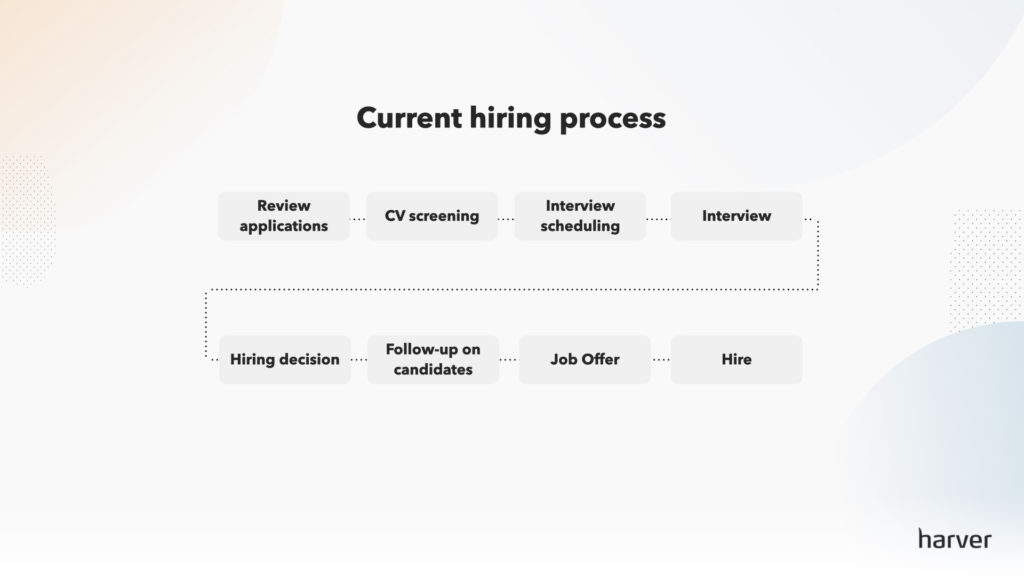
More often than not, recruiters rely on multiple tools when performing these tasks. Some steps are automated, while others aren’t, and this leads to a fragmented hiring process, which in turn results in a poor candidate experience.
The main issue with this traditional approach is that it isn’t streamlined, is manual-heavy, lengthy, and time-consuming. It isn’t scalable, it doesn’t predict future job success and it doesn’t deliver consistently high-quality hires. It’s also reactive, rather than proactive.
To put it succinctly – manual recruitment processes negatively impact all stages of your recruitment funnel, from sourcing, to selecting the right candidates, and scheduling interviews with them.
When you undertake a digital transformation of your contact center recruitment, therefore, you need to consider the full hiring cycle, taking into consideration both the recruiter and the candidate perspective.
The pillars of digital transformation in contact center recruitment
We have uncovered four major areas of technology that will fundamentally revolutionize your contact center recruitment.
- Matching technology
- Automation
- Candidate experience
- Business intelligence
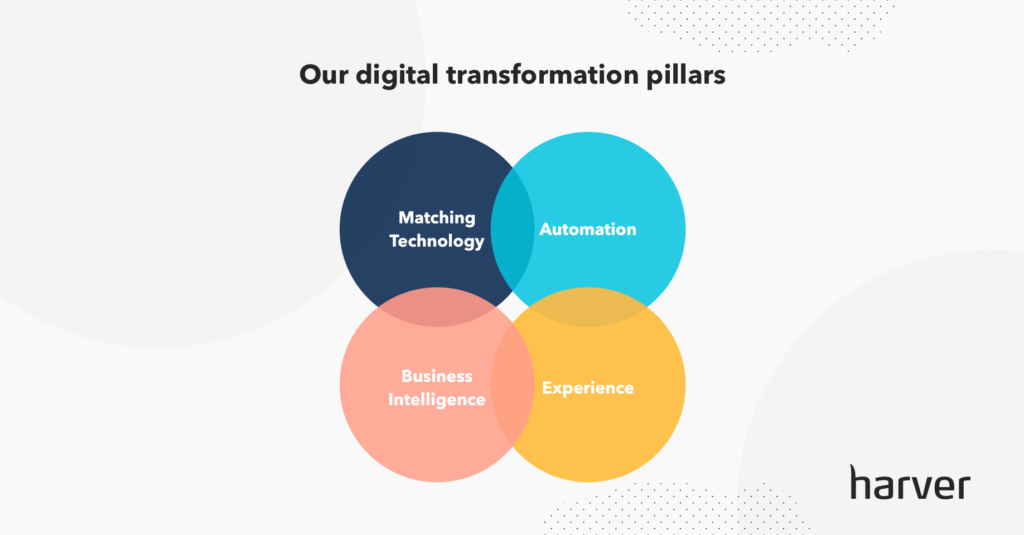
Matching technology
No matter the type of contact center role that you’re looking to fill, you should always start by identifying the key characteristics leading to success in your specific organization. From there, you can build a matching framework to help you find qualified people for the role.
In the common vacancy-driven matching, selection procedures are built around specific job descriptions, and organizations hire applicants to fill in specific roles, such as technical support agents or customer service agents for example.

Regardless of the position to fill, this approach is centered around the role and around a current need to fill a specific vacancy, rather than on the applicant’s skill set.
If we look at this from an assessment perspective, there’s nothing wrong with the approach, as long as you’re clearly defining the role and skills needed. However, in today’s reality, this process is inflexible and quite inefficient, especially when it comes to needing to accommodate a fluctuating talent pool across industries and markets.
Moreover, this approach focuses on a candidate’s past experience, which – in the context of contact center recruitment – is a weak predictor of future performance in this type of entry-level job.
For this reason, we use a new way of handling high volumes of applicants: call-type matching.
Call-type matching is a new approach to volume hiring, which matches the best-suited applicants across multiple opportunities and roles.
The matching is still specific for contact center types of roles, but instead of locking applicants into specific jobs, you take a talent-driven approach. This helps you connect the right talent to the right role by evaluating key characteristics proven to drive success across different roles.
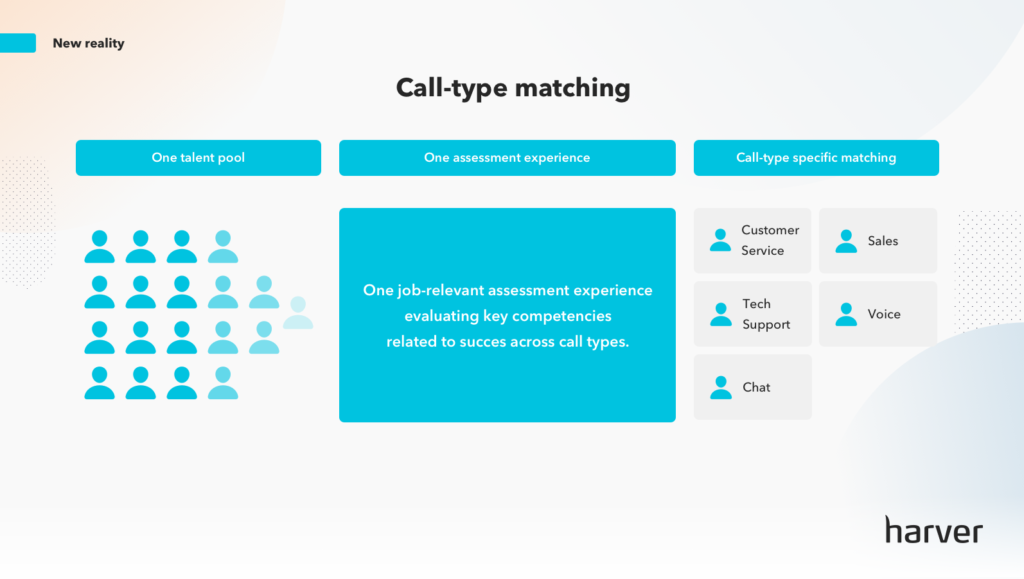
This increases the likelihood that you’re placing the right person into the right role and helps you avoid missing out on great talent that maybe was applying for a different vacancy but showed up to be a great fit for a technical support agent.
Ready to transform your hiring process?
Automation
Recruitment automation speeds up your workflow by quickly moving suitable candidates through your hiring funnel while rejecting those that are a poor fit. A faster workflow means fewer lost candidates and lower hiring costs, so you increase the likelihood of employing top-quality talent while keeping operating costs low.
While the depth of automation varies from one client to another, high-volume recruiters can automate virtually any step in the hiring process. In the scenario above, the candidate visits any job portal or career site and applies through a regular application form. From there, he or she is taken to either a client ATS or to the Harver platform, where automation kicks in.

When the candidate enters the auto-matching flow, they’re presented with a company video that helps them understand the environment they will work in. Then, they go through the assessments and if they fit the profile you’re searching for, they’re moved to the auto-scheduling phase, where they can select a time slot that fits their schedule.
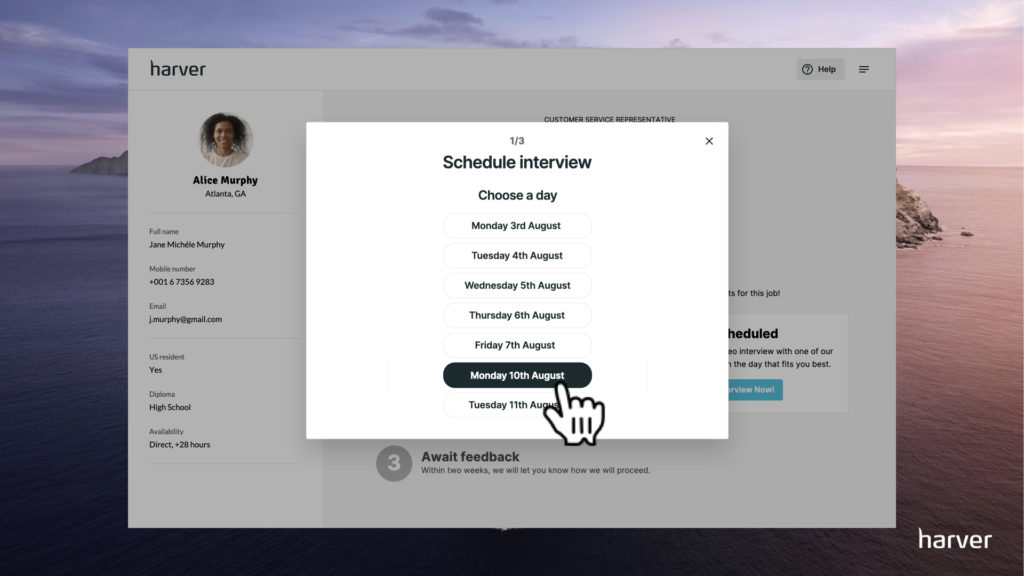
Your recruiting team can see in real-time who fits the role and who doesn’t, and they don’t have to interfere in this process at all, until the interview stage. This contributes to agile processes that are easy to scale up and down when demand changes. Thus, automation solves the problem of removing process inefficiencies from the recruitment funnel.
Candidate experience
Thanks to matching technology and automation, candidates receive a more informative experience about the role they’re applying for, so they can decide if they want the job or not before going through an interview.
The candidate journey is very different from the resume-based application. It’s engaging, short, and it assesses the candidate’s skills and fit for the role while giving them a very good preview of what the role entails.
Although employers can build various application flows, for contact center recruitment we recommend the Live Chat Simulation module, which gives candidates a realistic preview of the contact center agent role.
Experience our best-in-class Live Chat Assessment first-hand!
Perfect for remote hiring, our live chat assessment makes it easier than ever to hire live chat agents. Candidates experience the job, while you get actionable data to drive hiring decisions.
Once their application ends, candidates are asked for feedback, and the data is fed back into our system. This enables you to measure candidate experience while making it easy to see which stages of the process are causing bigger drop-offs.
Providing a digitized application experience is more in line with what candidates expect today, and leads to a better candidate satisfaction.
Business intelligence (BI)
The fourth pillar of our digital transformation framework is Business Intelligence. To make the most of your data, you need to be able to extract actionable insights in an easy manner.
Our platform offers real-time data through a series of out-of-the-box dashboards, but you can create your own reports as well if you want to track specific KPIs.
For example, one dashboard shows you candidate experience scores, such as how satisfied they were with the application; another report gives you insights into the matching scores of your candidates, enabling you to easily see how’s a good fit for the open roles.
Then we have the sourcing insights; when you work in high volume, you need to know what source gives you the best candidates, where your top performers are coming from.
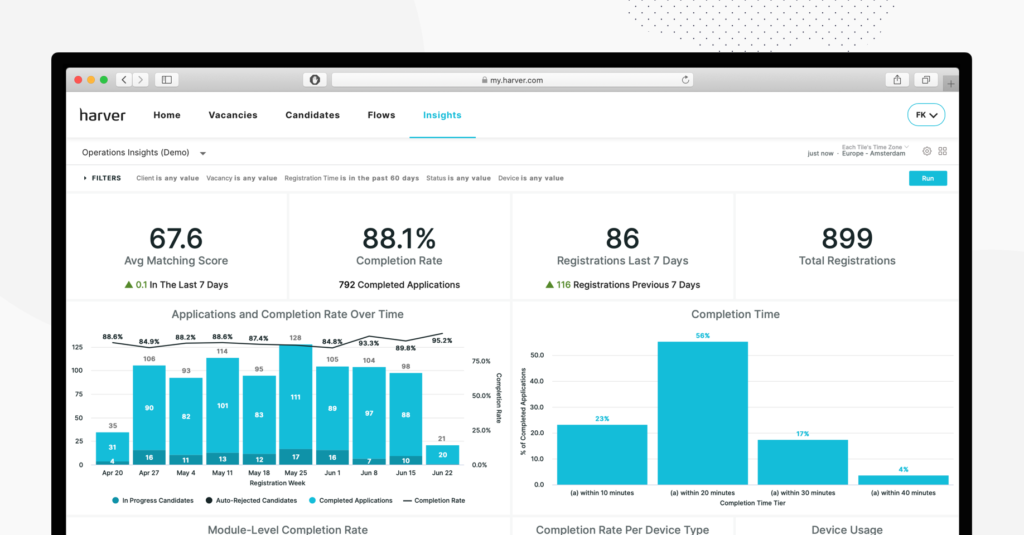
Finally, the D&I dashboard makes it easy to track DEI metrics and identify bias present across locations and recruitment funnel stages, helping your company follow through with your diversity and inclusion program.
Our BI solution is therefore suitable not only for interpreting candidate scores but also for optimizing your sourcing strategy to decrease your cost per hire and improve the quality of hire in the long run.
If you’d like to see how Haver can transform your hiring process,
book a demo here!
What digital transformation means for your organization
As previously stated, undergoing a digital transformation process is a challenge, but the benefits of doing so far outweigh the costs.

From a recruiter’s perspective, digitizing the manual, time-consuming tasks involved in the hiring process and using matching technology for selecting better candidates means:
- Faster time to hire
- Lower attrition rates
- A more streamlined recruitment strategy
- Hiring efficiency
- Insights into candidate and performance data via dashboards
- Better sourcing
- Easier to scale operations up and down
It’s all good and well knowing how digital transformation affects recruiters, but what about candidates?
- Candidates experience a seamless recruitment process.
- They have their expectations clearly managed by getting a better understanding of what the job is like through realistic job previews and by taking pre-employment assessments.
- They get to enjoy a gamified assessment.
- They get exposure to company culture earlier in the process.
- And all of this happens in a timely manner. No more waiting around.
- They get continuous communications – no more radio silence.
- They can filter themselves out if they don’t like what they see, avoiding the fear of rejection and avoiding wasting time with interviews.
How do you start digitally transforming your contact center recruitment?
The Harver platform provides you with an end-to-end digital recruitment solution that enables you to hire faster, better, and without bias. In big lines, here’s what you can expect when you partner with Harver to digitally transform your contact center recruitment process.
Stages of implementation
- we define the goals and scope of the project;
- we organize a series of workshops with your team to go through the roles that you want to hire for, look at the applicant journeys, identify the critical incidents and the best assessments to use, and decide how to best reflect your company culture and EVP during the application process;
- we analyze your employee performance data and benchmark the metrics to build custom SJTs;
- we analyze your tech stack to design an integration solution that accommodates your ATS and back-office systems;
- we define the BI solution that best fits your needs, then we develop the dashboards and train your team before going live.
- White paper
Before you continue!
Don’t forget to grab your free copy of our white paper on contact center volume hiring in 2021. Learn about:
-
The challenges currently shaping the contact e
center recruitment space - How employers can navigate the new remote-first reality, and the role of technology in a future-proof recruitment process
- The four building blocks of a fully digital recruitment process

Next steps
Undergoing a digital transformation isn’t an “if” for contact centers and BPOs anymore. With industry leaders experiencing an unprecedented volume of applications following COVID-19, if you want to survive 2021 and beyond, digital transformation is a “when”.
If you want to drive down costs, get better insights, improve quality of hire, reduce attrition and be able to hire at scale, consistently, you need to adopt a digital-first recruiting strategy.
Ready to transform your hiring process?



